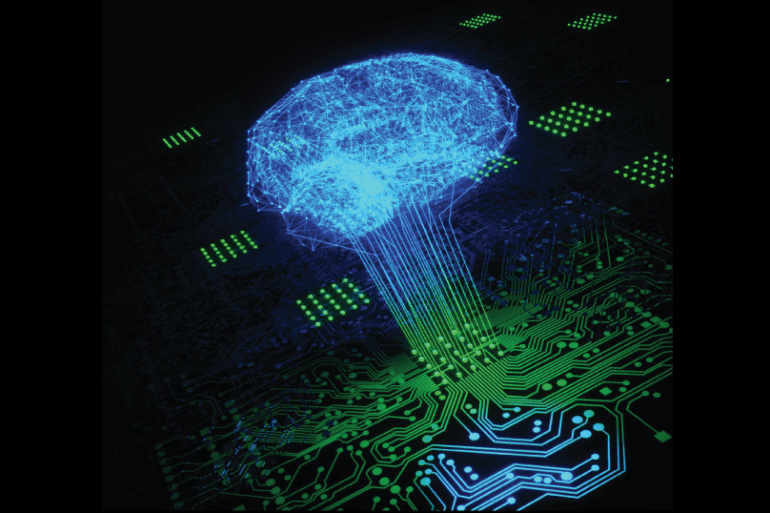TL;DR:
- MIT-led team introduces a breakthrough system for more potent machine-learning models.
- System utilizes light-based computations for efficiency and energy conservation.
- 100-fold improvement in energy efficiency and 25-fold increase in compute density achieved.
- Potential for large-scale optoelectronic processors in decentralized devices.
- Feasibility for commercial use in a few years with current fabrication processes.
- Pioneering technology could pave the way for unprecedented AI capabilities.
Main AI News:
The groundbreaking prowess of ChatGPT in generating essays, emails, and computer code from minimal user cues has reverberated globally. However, the realm of machine learning is on the precipice of transformation, as an enterprising team led by MIT presents a potential breakthrough capable of ushering in machine-learning systems several magnitudes more potent than the bedrock of ChatGPT. An added marvel is its potential to demand substantially less energy compared to the prevailing supercomputers, propelling modern machine-learning models.
Dated July 17, Nature Photonics unveils the pioneering embodiment of this novel concept. It rests upon the orchestration of light’s movement instead of electrons, ingeniously harnessing the might of hundreds of micron-scale lasers. This innovation culminates in an astounding 100-fold enhancement in energy efficiency and a 25-fold augmentation in compute density, signifying the prowess of this system in comparison to contemporary digital computers dedicated to machine learning.
Charting the trajectory towards the future, the research posits the promise of “substantially several more orders of magnitude for future improvement.” This trajectory is anticipated to unfold a landscape where large-scale optoelectronic processors unfurl their potential across data centers and decentralized edge devices. This audacious paradigm shift could empower devices like cellphones, historically relegated to rudimentary tasks, to execute programs previously reserved for colossal data centers.
What distinguishes this innovation further is its imminent feasibility. Leveraging fabrication techniques entrenched in current practices, this technology could conceivably be poised for commercial scalability within a few short years. The components that underpin this system draw from existing processes, the likes of laser arrays commonly seen in cell-phone face ID and data communication.
MIT’s Dirk Englund, a luminary in Electrical Engineering and Computer Science, articulates the profound implications succinctly: “ChatGPT is limited in its size by the power of today’s supercomputers. It’s just not economically viable to train models that are much bigger.” The radical paradigm advanced by this novel technology opens avenues to a realm of possibilities previously deemed unreachable in the immediate future.
Englund underscores, “We don’t know what capabilities the next-generation ChatGPT will have if it is 100 times more powerful, but that’s the regime of discovery that this kind of technology can allow.” Englund, renowned for his leadership in MIT’s Quantum Photonics Laboratory, encapsulates the essence of this transformative leap.
A Crescendo of Achievement
The current milestone stands as the zenith of a crescendo of achievements that have unfolded over recent years, orchestrated by Englund and his collaborators. In a seminal precursor, Englund’s team in 2019 laid the theoretical foundation that birthed this manifestation. Ryan Hamerly, the principal author of that foundational paper, is also instrumental in the current innovation.
The roll call of coauthors gracing the pages of the Nature Photonics paper includes Alexander Sludds, Ronald Davis, Ian Christen, Liane Bernstein, and Lamia Ateshian, all hailing from MIT’s Research Laboratory of Electronics. Additional contributions are extended by Tobias Heuser, Niels Heermeier, James A. Lott, and Stephan Reitzensttein of Technische Universitat Berlin.
The Light-Powered Odyssey
Deep neural networks (DNNs), the backbone of ChatGPT, emulate the human brain’s information processing through intricate machine-learning models. However, the digital architecture propelling contemporary DNNs finds itself grappling with constraints as the sphere of machine learning burgeons. These models are energy-hungry and confine their operation to expansive data centers, propelling the quest for transformative computing paradigms.
The allure of employing light in lieu of electrons to orchestrate DNN computations presents the prospect of surmounting these constraints. Optical computations harbor the potential to mitigate energy consumption in contrast to electronic counterparts. Furthermore, the intrinsic qualities of light offer expansive bandwidths, fostering information transfer over a compact expanse.
Navigating Challenges with Ingenuity
However, existing optical neural networks (ONNs) wrestle with formidable challenges. Their energy consumption is notably high, stemming from inefficiencies in converting incoming electrical energy into light. Additionally, the associated components are bulky and space-consuming. While excelling at linear calculations, ONNs falter when confronted with nonlinear computations such as multiplication and conditional statements.
In a groundbreaking feat, the research team introduces a compact architecture, a panacea that concurrently addresses these challenges. This innovative construct pivots on state-of-the-art arrays of vertical surface-emitting lasers (VCSELs). This technology, notable for applications including lidar remote sensing and laser printing, epitomizes a symbiotic alliance between academia and innovation.
Endorsement of Innovation
Logan Wright, an esteemed figure at Yale University, lauds the work undertaken by Zaijun Chen et al. as a source of inspiration. He foresees a promising trajectory, wherein systems founded upon modulated VCSEL arrays could potentially pave the way for expansive, high-speed optical neural networks. While pragmatic utility remains aspirational, optimism prevails for the realization of these prospects, particularly in ameliorating colossal AI systems like ChatGPT.
Conclusion:
This groundbreaking advancement could revolutionize the machine-learning market. The potential to create more powerful models with significantly reduced energy consumption opens doors for transformative applications across industries. From augmented AI capabilities to enhanced data processing in decentralized devices, this breakthrough underscores the pivotal role of cutting-edge technology in shaping the future market landscape.

